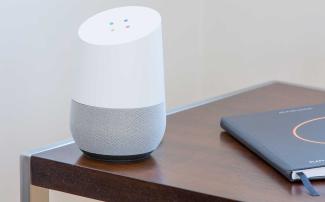
Investment to Watch: Smart Home Technology
The term “smart home” sounds like something out of a movie on Syfy or a place where intelligent people go to converge. Yet, the concept isn’t new by any means. John Chambers, CEO of Cisco, referenced the concept at the Consumer Electronics Show in 1999. Now, almost 20 years later, the components that comprise a smart home are becoming an increasingly present part of everyday life.
What Actually is a Smart Home?
Definitions may differ depending on who you reference, but essentially the smart home is one that has network-connected products that preform functions for controlling, automating, and improving living elements like security, air filtration, and temperature. This is a far cry from when lights on a timer to throw off potential burglars could have been considered part of smart home technology! An associated phrase to know is the “Internet of Things,” (IoT). IoT refers to the added internet connectivity and sensors to regular product; the smart home just one of the settings for potential IoT applications, but is the most popular and ripe for innovation.
Smart Stuff
Some examples of products you’ve probably already heard of include Nest, which makes a full line of smart products from smoke alarms to security outdoor cameras to their most popular product—the smart thermostat. Also, the Amazon Echo device, with the voice assistant Alexa, has expanded the realm and accessability of linking your smart home together. Not only can it do basic voice commands like an internet search or report a sports score, it also integrates with connector products (that combine multiple smart devices) such as SmartThings, as well as other smart devices like Sensi (Wi-Fi connected thermostat), and Philips Hue Lights (smart lights that can sync with music and movies, among other things). Ring lets you answer your doorbell remotely. There’s even a tool to render your dustpan retired; the Bruno SmartCan features a vacuum at its base and tells you via app when it needs to be emptied or have trash bags added.
Automation port Wink perhaps best explains the functions of the in-app robots with this example: “…you can make your Kwikset SmartCode Deadbolt© tell your lights and A/C to turn on every time you unlock the front door.” Sounds handy right? The interconnected smart house is slated to make life easier, simpler, less complicated. Forgot to turn the coffee pot off after leave for vacation? No worries, you can control it from your phone. Concerned why your home security system is on red alert? Check the camera from your tablet to confirm it’s just your friend coming over.
Reasons for the Watch List
If this sounds like the “next big thing” and a potential area for investment…it is. Smart home market values are expected to rise from to $121 billion in 2022, which is substantial considering the value was at $46.97 billion in 2015. Within the market, certain products are expected to be more popular than others; lighting control products that reduce electricity usage are expected to grow along with smart meters that record home energy consumption for utility companies. In 2015 these smart meters held the biggest share of the market; the meters also help individuals reduce energy usage and bills by communicating the usage data to consumers. Additionally, 56% of people who own one or more smart home devices would like to buy similar smart products in the coming year, according to CEPro. In the millennial age demographic, 41% were interested in owning smart home products.
Products that are seeing the biggest uptake are those that are easy to install and connect with other products. Incentives such as those from insurance companies, for products like a smart smoke alarm are also doing well. The real estate industry may also be a driver in adoption as homes are built with smart home technology already installed.
Barriers to Growth
This market is certainly one to watch. If you’re not sold on investing yet, it’s understandable. A small 6% of American households had a smart home product as of 2016, Forrester reported. And, by 2021, that number will only increase to 15%.
According to a 2016 survey by consulting firm PricewaterhouseCoopers, 72% of people surveyed in Britain are not willing to pay for the smart house technology and don’t plan on adopting any smart home products in the next two to five years. The price point being a major issue is apparent when a smart fridge that tells you when you’re low on specific groceries costs $5,000; when smart products cost more than double their “dumb” counterparts it’s difficult to overcome human apathy and internal convincing that the regular, cheap, old $3 light switch is just fine.
Louise Keely, president of The Demand Institute, addressed the situation: “Smart home products need to demonstrate clear value and solve unmet consumer needs before most will make the investment. Some of these products do meet that bar, but many still feel these products are gimmicky, even though 64 percent concede that they really do not know much about smart home technology.”
The complexity is also intimidating to less tech-savvy populations. The integration hubs, such as Apple’s HomeKit, where you can control multiple functions of different connected products from one app are the winner in this issue. But, this still take a significant amount of time to initially setup. When the general public does start catching on to the IoT, they’ll do so with one or two smart products. If they work well and are helpful, then people are likely to expand their arsenal of appliances and tools.
Where to Start
If you are ready to invest, safe bets are with the bigger name companies that are likely to make money from this initial push for smart house technology. Companies like Alphabet, Amazon, and Apple will lead the charge with the brand and the marketing to back up their investments. Return on investment won’t be coming from smart home products anytime soon in any major way, but these companies have banked on success in the future and are getting into the market early with their products. Avoid the singular products that have limited integration or expansion capabilities. Look to companies that integrate products to make your home’s infrastructure more energy-efficient, affordable, and to make the set-up ultimately easier for you. For example, SolarCity and Nest formed a partnership around a shared vision; SolarCity also formed a partnership with Tesla Motors for energy storage and monitoring.
Resources
- http://brunosmartcan.com/
- https://nest.com/
- http://lifehacker.com/the-seven-best-things-you-can-do-with-an-amazon-echo-1766989219
- https://sensicomfort.com/
- http://www2.meethue.com/en-us/
- http://www.businessinsider.de/internet-of-things-devices-applications-examples-2016-8?r=US&IR=T
- http://www.marketsandmarkets.com/PressReleases/global-smart-homes-market.asp
- http://www.economist.com/news/business/21700380-connected-homes-will-take-longer-materialise-expected-where-smart
- http://cnyrealtor.com/feed/report-smart-home-tech-slow-catch
- http://demandinstitute.org/
- http://cnyrealtor.com/feed/report-smart-home-tech-slow-catch
- http://www.nextgov.com/mobile/2017/02/video-smart-home-revolution-slow-start/135293/
- http://www.cepro.com/article/infographic_millennials_genx_biggest_adopters_of_smart_home_devices#
- https://www.forbes.com/sites/panosmourdoukoutas/2014/01/25/how-to-invest-in-the-smart-home/#18fa2f403bd1
- https://www.fool.com/investing/general/2016/05/07/the-race-to-the-smart-home-future-is-on.aspx
*This content is developed from sources believed to be providing accurate information. The information provided is not written or intended as tax or legal advice and may not be relied on for purposes of avoiding any Federal tax penalties. Individuals are encouraged to seek advice from their own tax or legal counsel. Individuals involved in the estate planning process should work with an estate planning team, including their own personal legal or tax counsel. Neither the information presented nor any opinion expressed constitutes a representation by us of a specific investment or the purchase or sale of any securities. Asset allocation and diversification do not ensure a profit or protect against loss in declining markets. This material was developed and produced by Advisor Websites to provide information on a topic that may be of interest. Copyright 2021 Advisor Websites.


